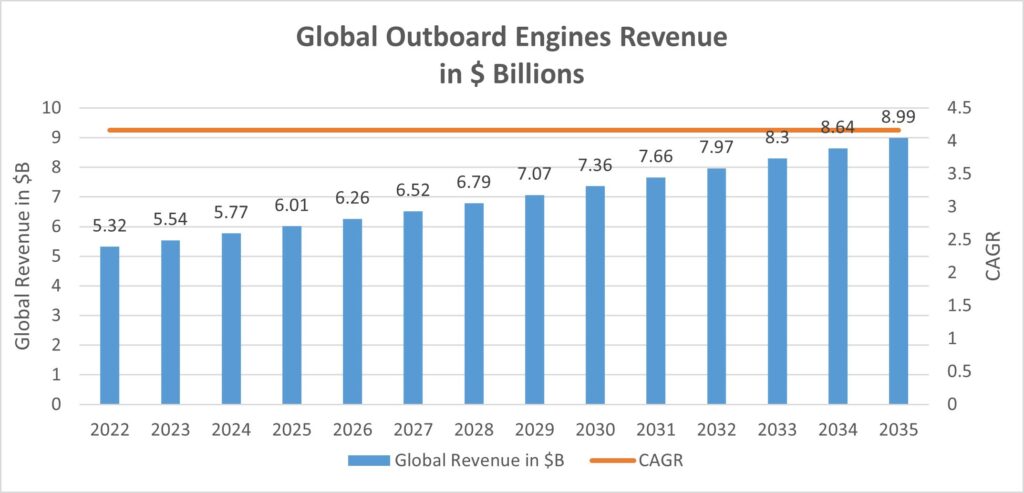GLOBAL REPORT

The global Outboard Marine Engine Market size is estimated at $5.54 billion in 2023, and is expected to reach $8.99 billion by 2035, growing at a CAGR of 4.1% during the forecast period, according to research by Power Systems Research.
The COVID-19 outbreak significantly impacted the boat manufacturing industry and caused a decline in recreational activities worldwide, which hurt outboard motor sales. However, in 2021, the market regained momentum due to the easing of restrictions. The market is expected to register healthy growth in the coming years.
There are generally three types of boat drives including inboard, outboard, and sterndrive. One obvious distinction among them is their placement of motor in the boat.
Different from an inboard engine that is usually mounted inside the boat and invisible or a sterndrive that is a combination of inboard and outboard engines, an outboard motor refers to the propulsion system fully installed on the outside of the hull, usually mounted to the exterior of the transom to power the boat.

Source: Power Systems Research
In addition to offering propulsion, an outboard engine that sits on the boat also offers steering control as it’s built to pivot over its mountings and adjust the thrust’s direction. Often, the outboard motor is the first choice for fishing, recreation, and light commercial inshore boats.
There are several demand drivers for the global market, including:
- Overall Economic Growth. Rising disposable income has resulted in increased spend on leisure and recreational activities and increasing demand for small and medium-powered boats, which has contributed significantly to the rapid growth of the watercraft industry.
- Rising Sales of Boats. The global marine outboard engines market is heavily dependent on the demand for powerboats such as pontoon boats, personal watercraft, ski boats, saltwater fishing vessels, and wakeboards. Recreational boat demand increased during COVID years and decreased significantly in 2021 and 2022. But boat demand is forecasted to return to normal growth in 2023.
- Boat/Engine Suppliers are increasingly emphasizing new products. Manufacturers are increasingly integrating advanced technologies, such as IoT, AI and smart sensors into their boats providing users with features such as GPS tracking, automatic controls and smart connect.
- Rapidly growing water tourism industry. Rising watersports and boating activities are increasing the demand for outboard engines. The U.S. is witnessing significant growth in product demand from marine industry due to many activities like sightseeing, voyages, swimming, nature observation and entertaining.
It’s important to note that the electric and hybrid-electric power systems we see in vehicles designed for use on land will unlikely be mirrored in the marine world, at least not in the near term especially with higher hp engines.
On small boats the power and range limitations aren’t too problematic and small electric outboards have continued to gain ground. But for larger boats travelling long distances, this remains a big problem to overcome. On larger boats, internal combustion outboards aren’t likely to go away any time soon. PSR
Michael Aistrup is Senior Analyst at Power Systems Research


